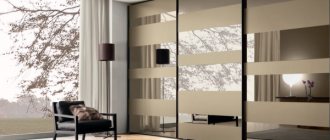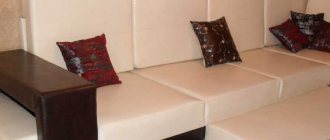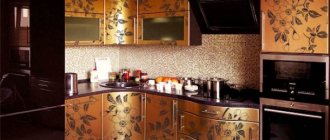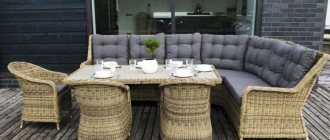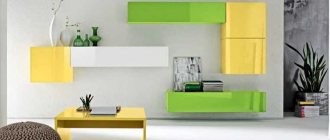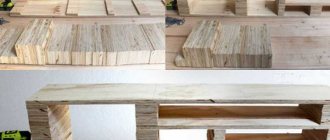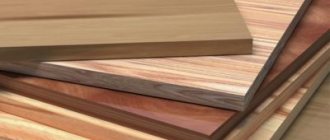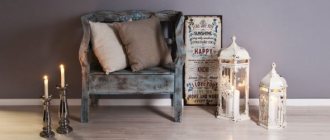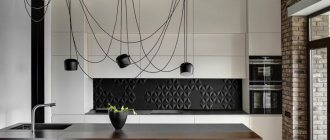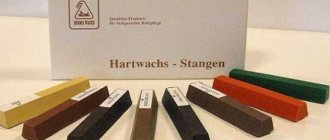44203
For a long time, chipboard (chipboard) has been used as the basis for furniture. For those who have minimal skills in working with wood and carpentry tools, homemade furniture will provide an opportunity to significantly save the family budget. Do-it-yourself furniture made from chipboard will be exclusive and will take its rightful place in your apartment. Everything you need for work can be found in specialized stores.
In what cases do you need hand-made furniture?
Let's look at a few situations where making furniture yourself can be justified.
The first case is described above, when the room has a non-standard size or configuration. It is not possible to select factory furniture for such a room. And ordering from a furniture company will be too expensive.
Creating your own version of furniture will not only help you save money, but will also bring emotional satisfaction from the work done.
Advantages of MDF furniture
- Furniture made from unpainted MDF is inexpensive;
- MDF can be painted in almost any color; it is chosen at the design stage;
- The material is not afraid of high humidity;
- Ability to create smooth shapes;
- Resistance of the coating to friction and chemicals;
- Various coatings for facades. Possible coating with varnish, paint, laminate. The surface can be glossy or matte;
- Durability;
- The ability to make not only facades, but also tabletops from MDF.
Furniture manufacturing options
Some furniture owners are faced with the choice of giving their furniture a second life or buying a new one. Therefore, the question: how to repair chipboard furniture with your own hands is often quite relevant.
Let's look at several options for solving the problem of filling a room with quality furniture.
Classification of slabs
Single-layer and two-layer boards are not used in the furniture industry due to insufficient strength. Three-layer or more options are used in furniture production. Their thickness ranges from 8 to 40 mm.
There is no standard size and depends on the specific manufacturer. Typically, the length of the sheet ranges from 1.8 to 5.6 meters. The width varies from 1.2 to 2.5 m. Changes in the indicated values by 2–3 cm are allowed. The slabs are divided into non-waterproof and waterproof, capable of withstanding humidity up to 85%.
Benefits of leather furniture, tips for arranging and caring for it
| Brand of particle boards | Functional Features |
| P1 | Designed for use in dry rooms, rough, does not support load-bearing loads |
| P2 | Corresponds to the functional parameters of P1, has a smoother surface |
| P3 | Moisture-resistant, can withstand humidity up to 85%, and can be used for a short time when the parameter is increased. Can't withstand load bearing |
| P5 | Moisture-resistant, comparable in characteristics to OSB boards |
| P7 | Can be used in damp areas and under heavy loads |
The availability of raw materials ensures the low cost of produced materials. At the same time, the slabs and furniture made from them must comply with environmental safety standards and not harm health during operation. Since harmful formaldehyde is used as a binding element, which provides the products with significant strength, the finished sheets differ in the amount of adhesive they contain:
- E0.5 - intended for dry rooms, due to the small amount of adhesive component they have insufficient strength;
- E1 - used in interior decoration and furniture production;
- E2 - they are not used indoors.
The slabs must be marked. Since formaldehyde is a highly volatile compound that can be released into the air, for a long time there was an opinion that chipboard products were harmful to health. The development of new materials for finishing slabs has made it possible to almost completely eliminate this drawback. In addition, they differ in the type of surface:
- unpolished - used in construction, thickness is 8–10 mm;
- polished - used in interior decoration and furniture production, thickness varies from 16 to 19 mm;
- lined or laminated - covered with a decorative layer that can imitate paint, various types of wood, used for the manufacture of carpentry structures, can have a width from 19 to 28 mm.
Lined types emit virtually no formaldehyde. Furniture made from such materials is safe to use. There are also different types of chipboard depending on the outer covering:
- rough - do not have a decorative layer;
- laminated - covered with decorative paper film impregnated with resin;
- laminated - got their name due to the corresponding film with which they are covered;
- veneered - covered with a thin layer of natural veneer.
All these options are used in furniture production. Rough chipboards can be painted, stained or varnished. They are often used in making furniture with your own hands.
Draft
Laminated
Laminated
Veneered
New furniture
Thus, making furniture from chipboard with your own hands makes practical sense if the owner of the premises does not have furniture at all, or if the furniture that exists is morally and physically outdated.
Of course, to manufacture new furniture, it is necessary to develop its detailed drawing. After this, you need to draw out the detailing of all the details.
If we talk about the manufacture of parts, then you can go in two ways:
- Order the cutting of parts and their trimming from a cutting company, although it will be more expensive, but the accuracy of manufacturing the parts is higher.
- Make the parts yourself by cutting them from a whole sheet of furniture chipboard. Then trim the parts manually. So the parts will cost less, but their quality will be lower and this work will take much longer.
Where to order furniture parts from laminated chipboard by size in Moscow?
Furniture factory "MEBELINNI" offers you a wide range of services for cutting, edging and adding board materials. We work with laminated chipboard and MDF and undertake to produce parts of any size and shape for the further production of cabinet furniture - cabinets, kitchen or bedroom sets, hallways, etc.
All work on cutting furniture parts is carried out using automated high-tech equipment. The production employs experienced workers who are able to cope with a task of any complexity and only with high quality.
Our factory carries out various works related to cutting laminated chipboard and MDF:
- straight and curved cuts of slab material;
- deducing radii;
- making templates;
- edging parts with PVC edge;
- drilling holes for confirmations, ties, hinges and other types of operations according to your order.
Our furniture factory also produces cabinet furniture according to customer sizes, produces cabinets and facades for kitchen sets, furniture walls and sliding wardrobes. We work with both our own and the customer’s materials. We always have a large selection of countertops, wall panels, laminated chipboard and MDF in different colors and textures, and furniture fittings.
Restored furniture
Do-it-yourself restoration of chipboard furniture is relevant if the restored furniture is of historical or antique interest.
In addition, the material from which the furniture is made and how it was preserved are taken into account. In this case, only the part that needs to be replaced is manufactured.
This option is interesting when recreating expensive pieces of furniture that were damaged for one reason or another.
Reviews on product use
Experience in using furniture made from particle boards suggests the following:
- Chipboard material is quite durable, but can quickly collapse under a strong impact;
- pressed slabs are resistant to small amounts of moisture and rot when exposed to it for a long time;
- The flammability of the material is low. Despite this, chipboard should be used in the kitchen with caution;
- You need to pay attention to the environmental performance of sheets when decorating a children's room and purchase only materials that are improved in terms of toxic safety.
Chipboard is gradually being replaced from use by safer wood boards, although it is premature to talk about their immediate replacement. Pressed particle boards are still used in the manufacture of furniture and decoration, when the use of other materials is more expensive. Modern chipboard compositions are distinguished by high technological qualities and often turn out to be the winner in the choice among less practical compositions.
Photo of what can be made from chipboard:
Kitchen furniture set
Closet
Floor shelf
Chipboard shelf
Twins tables made of chipboard
Living room table
Chipboard table
Refurbished furniture
The question of how to update chipboard furniture with your own hands arises when the furniture is of good quality and quite fashionable, but has flaws that need to be corrected.
How to make a table with your own hands: materials and tools for work. Drawings of the future table, assembly features. TOP 100 photos of popular options for homemade tables - kitchen, coffee, writing- How to make a mirror with your own hands? Mirror made of bronze and steel, aluminum, foil. Step-by-step instructions with photos: selection of material, trimming, silvering, applying a protective layer
How to make a countertop with your own hands: materials and tools for work, assembling formwork and frame, preparing and pouring concrete mortar, facing the countertop
Often these are door hinges, handles, drawers and the like. It is quite rare to have to change relatively large parts. This is one of the cheapest options.
But when changing furniture fittings, if you cannot find exactly the same part, such as, for example, a cabinet or drawer handle, you will have to change all the handles of the set.
Manufacturing stages
At first, it is not always clear to a beginner what to tackle first. You can find a simple master class in open sources, but in many videos and instructions they rarely pay attention to dividing the work into stages. But a detailed description is very important, as it helps to do everything consistently, quickly, and at the same time with high quality.
How to arrange furniture in a one-room apartment, advice from designers
Drawing
A prerequisite for starting work is to find or complete a furniture drawing. It is compiled manually or using special programs on a computer. You can also find ready-made drawings in forums for craftsmen. You need to have at least the slightest skills in reading diagrams if they are taken from a third-party source. Drawings are not always correct; they need to be checked. If you don’t have such a skill, then you should consult with a knowledgeable person.
Detailing
This is called drawing up a diagram of individual parts of a product. This approach will allow you to divide the assembly process into stages. Also, from a solid drawing it is not always possible to determine the exact dimensions of the constituent elements. Having initially spent more time at this stage, it will then be much easier to assemble the furniture and make individual parts for it.
Cutting, processing of slices
When you have an idea in your head of what needs to be done, and how to get it is reflected on paper, cutting the material into sheets of the required size begins. It’s worth making as many of them as you need at once, and cutting out individual elements from each piece. It will work faster and easier this way.
After cutting, it is necessary to process the cuts. Even the best quality tool will leave nicks in the material. Sandpaper or felt cloth is used for processing.
Drilling holes for fasteners
Already on the finished parts, using a drill and a drill or a screwdriver, all the holes are made. This stage should not be taken lightly. Chipboards are very sensitive to such procedures, so you need to be careful. It is necessary to know the exact diameter of the holes in advance. You will not be able to change them in the future.
Assembly
Only after all the stages comes the furniture assembly itself. There is nothing complicated here anymore if the master thought through the drawings in advance and chose the right fasteners. The only thing you need to be careful with is the sensitivity of the material to drilling, screwing and any deformation. Too much force may strip the threads. It will not be possible to re-screw the screw into this hole; you will have to make a new one.
Finishing
The final stage is finishing and decoration. The varnish coating is responsible for how long the furniture will last. A good product will protect against deformation and moisture. You can also use a special film instead. If you plan to paint furniture, then it is done before applying a protective layer and with preliminary treatment - sanding, cleaning, leveling the surface. There is no need to think about how veneer cladding is done at home. This is a complex procedure that can only be performed in a factory.
The main stages of making cabinet furniture with your own hands, tips
Tools necessary for making furniture
The list of necessary tools will largely depend on which path the owner of the furniture will take. If you order ready-made parts from a cutting company, then such a list will be minimal. It could be:
- screwdriver
- nozzles of various configurations
- hammer
- plumb line
- square
- screwdrivers
- roulette
- pencil
With such a minimal set of tools, you can perform high-quality furniture assembly.
The procedure for assembling furniture with your own hands
When solving the problem: how to assemble furniture from chipboard with your own hands, it is important to remember that at the beginning the furniture frame is assembled, that is, the largest parts, and then small parts are assembled and added to the frame.
Do-it-yourself stone tabletop: step-by-step master class with photos! Preparatory work, drawing creation, materials and toolsDIY wall clock: 80 photo ideas for inspiration. DIY wall clock design - bright clocks made of plastic spoons, clocks with a moon print, eco-clocks made of moss, cork wood, knitted cuckoo clocks, clocks made of a piece of plywood
DIY rocking chair: types of rocking chairs and materials, process of making a rocking chair. 75 photo ideas on how to make a beautiful and comfortable chair yourself
Cutting laminated chipboard according to individual parameters in Moscow and the Moscow region.
In order to cut laminated chipboard, it is important to have professional equipment , thanks to which it will be possible to make furniture according to individual parameters. Such equipment is capable of creating perfectly smooth cutting edges and sharpening angles. In addition, some models also have jewelry processing functions.
However, in this matter, the professionalism of the master who works on such equipment is also important. When cutting laminated chipboard correctly, waste is minimized, and the quality of the finished product increases. In addition, it is necessary that the chipboard cutting is carried out in the appropriate room. Space for work, good ventilation and stable temperature data must be observed when cutting laminated chipboard for furniture elements.
Photo of DIY furniture made from chipboard
DIY floor hanger: materials and tools for work. Extraordinary photo ideas for creating a hanger - a hanger in the form of a tree, hangers made from natural elements, a hanger in the form of a ladder- Kitchen chairs: review of the best new products and modern design
Do-it-yourself furniture restoration: restoration ideas, affordable design options and a master class on updating old furniture (120 photos and videos)
Read here - Do-it-yourself bag chair: step-by-step instructions and master class for making frameless models (125 photos and videos)
Help the site, repost 
0

